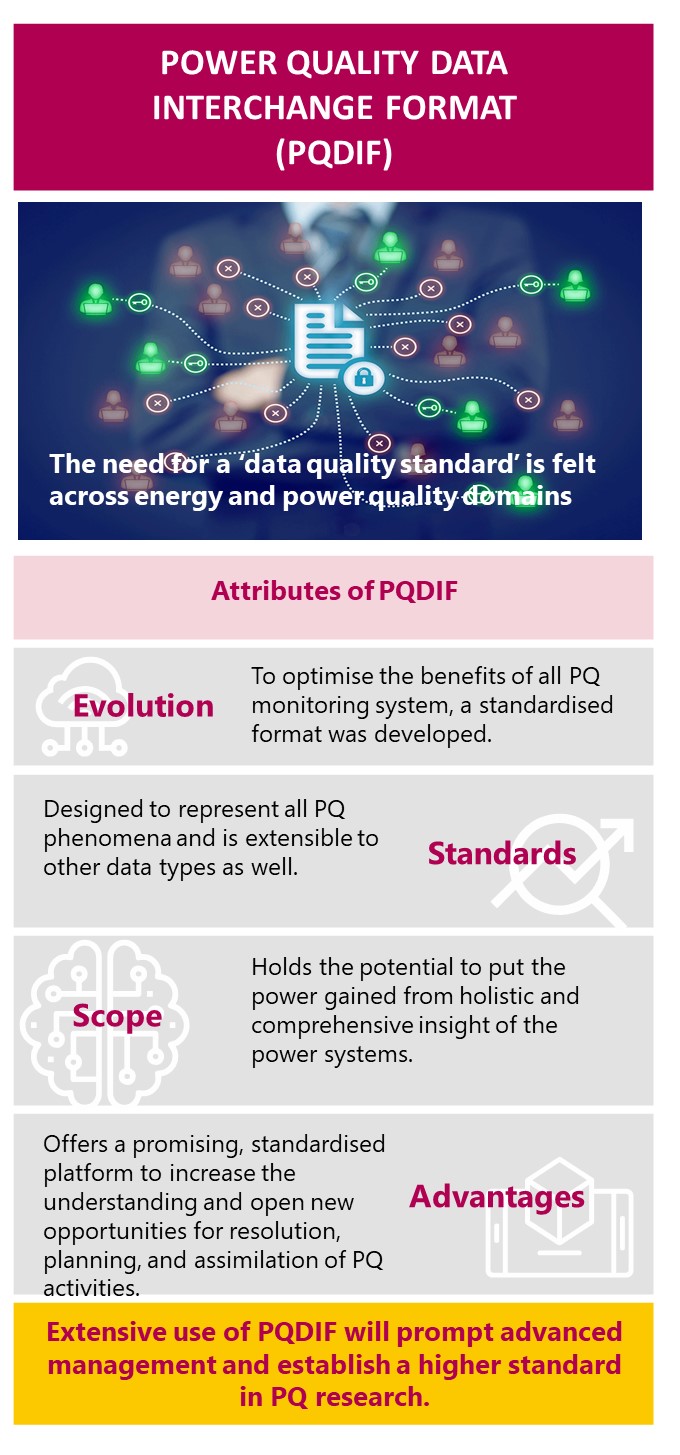Published On: Jul 05, 2020
The essence of life is in the connected world and collaborations. The exchange of information and a common platform to express it in a language that the world would understand connects us. Connections not only put us together but also enlarge and enrich the scope of life. In the era of biologically, philosophically, and technologically smart world, interconnections play a crucial role to get us through. Power Quality in electrical network is interconnected by default and evolution of PQDIF is key to understanding the world of PQ.
INTRODUCTION
We are at a juncture where digital is at core of each of our connections. It’s not uncommon today to send a message on cellphone to the person sitting next to us or in the same room rather than speak to him or her directly. We are more comfortable with digital than real. The digital and interconnected nature of the future is undebated. It promises to make our lives smarter and better. In the process, several things that we use are undergoing a silent transformation as they upgrade and strive to achieve better inter-connectivity – a key to evolving and surviving in the digital world of the future.
The evolution in technology that we see today are created more out of such evolved interconnections. Take for example the apps we use on our smartphones are backed by the smart technology popularly known as the API- Application Programming Interface. The API is a language for software to talk to each other. A protocol among the apps to share information with each other. Ever wondered how Trivago compares the prices from all other travel websites or MakeMyTrip getting you all airlines options and makes you choose the best deal? The API technology is at work here, which accesses the database of these websites and brings out the comparisons to process your bookings smartly. A similar need is being felt across all the industries undergoing the digital transformation.
THE ROLE OF STANDARDS IN ENABLING INTERCONNECTIONS
The widespread use of interconnecting technologies in different areas of industry gives rise to subsequent other factors. First and most important being the need for a standardized format that can encode the interchange of information derived from different applications. Many areas including the health sector, IT, financial, as well as electrical research and development face the difficulty of establishing a common platform for their communications among different instruments. With greater digitization comes the need for greater standardization. In the power sector, the need for a ‘data quality standard’ is felt across energy and power quality domains.
The increasing use of complex and higher order digitization in electric devices demands the need for a common data interchange format. The intricacies of digitized electrical equipment further create the need to build and bring into application a uniform platform to share as well as understand the nature of Power. Observing the Power Quality, in particular, for reliable and safe energy and better ‘quality’ life is dependent on the successful evolution of the data interchange platform.
With the rapid use of nonlinear loads in every industry, associated power quality issues have become noticeable and increasingly essential to be addressed. Discrepancy in the PQ can cause problems like reduced life expectancy of the instrument, malfunction, performance degradation, or also equipment failure. To avoid these PQ issues, continuous monitoring of PQ is essential. But the key to understanding the deep interconnections in the electrical network to further improve its quality of power is the evolution of Power Quality Data Interchange Format (PQDIF).
EVOLUTION OF PQDIF
The need for PQDIF is made evident by the very nature of PQ. How do you observe and analyse something in silos that has come into existence because of the interconnections?
It all started with different utilities using their own PQ data management systems to monitor PQ. Interlinking of such data from various set-ups would enlighten about finding solutions to PQ-related issues in general as well as aid further research in the area.
To optimize the benefits of all of the PQ monitoring systems, an integrated file format was initiated by the EPRI- Electric Power Research Institute and standardized by the IEEE Power Engineering Society Task Force.
Power Quality Data Interchange Format – commonly referred to as PQDIF is a binary file format that transfers the data between different software applications and power quality monitoring devices.
A disparate approach to observing and analysis PQ defeats the very purpose of such activity. PQDIF holds the potential to put the power gained from holistic and comprehensive insight of the power systems, back into the hands of researchers and users.
PQDIF – KEY TO UNFOLDING PREVIOUSLY UNAVAILABLE INSIGHTS
The sum of parts is greater than the whole!
The fact matters even more when it comes to monitoring and analysing PQ where the whole influences the parts and vice versa. PQDIF is at the core of monitoring PQ and whether it’s used in a regular or advanced PQ Analyser or any other equipment that streams PQ related data, the format is critical to make sense of the whole.
The analysis advantage
Adaptation of a common PQDIF standard will enable a huge potential to understand and decipher PQ. At its core, understanding PQ is all about identifying patterns and co-relations. Better and greater data aids the insights. PQDIF will enable collation of data from disparate sources into a single stream and readying it further for advanced computational analysis using analytics, machine learning and more. Such large-scale analysis of data holds the potential to unearth previously unavailable insights about the nature of PQ and its influences more clearly.
The intelligence advantage
With the ability to analyse data faster using advanced tools, coupled with a protocol to exchange data among the devices and instruments further allows for intelligence in the way PQ is managed and improved. For instance, a built-in analytical engine in a high-end MRI scanner, if able to talk to the feeder supplying power, the exchange creates the possibility of handling the PQ issues in a whole new way. An ability to seamlessly talk to each other is key to bringing this possibility into reality. The API revolution in software is a point in the case. With better dialogue and higher computational capabilities the equipment of the future can be expected to intelligently resolve the PQ issues between themselves rather than relying on human expertise. The basis for such a future is embedded in exchange of information and data interchange platform for PQ.
CONCLUSION
The success of standardization in the banking and finance area can be better explained by the standardized ATM card. It has enabled us to withdraw cash from any bank even if it is outside our bank network.
Same way, the versatility and flexibility of PQDIF makes it smart and must-have alternative to address problems related to PQ monitoring. Its extensive use will not just prompt an upgraded management of PQ monitoring but also help establish a higher standard in the PQ research. PQDIF offers a promising standardized platform to increase the understanding and open new opportunities for resolution, planning, and assimilation of PQ activities. As a user when one looks at alternative technology provider for PQ monitoring, one will do well by keeping this aspect in mind and seeking compliance to relevant standard of the day to avoid being at a loss in later stage. Such technologies and their extensive acceptance is surely a way forward on the path of the digital India!
REFERENCES
- PQ Monitoring a changing market – https://www.ecmweb.com/power-quality-magazine-archive/article/20885169/power-quality-monitoring-a-changing-market
- PQDIF Standards IEEE – http://grouper.ieee.org/groups/1159/3/
- PQ Monitoring and data interchange – http://cired.net/publications/cired2015/papers/CIRED2015_0258_final.pdf
- PQDIF Introduction – https://docplayer.net/21015468-About-the-power-quality-data-interchange-format-pqdif.html








